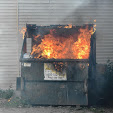In the early 20th Century, American consumers were offered an alternative to the small revolvers and derringers that had been the standard in pocketable firearms for some fifty years: smaller versions of the new "self-loading" semiautomatic pistols.
 In 1903, Colt's offered their .32 Automatic Pistol, known as the "Model M" or "Pocket Hammerless". Equipped with both thumb and grip safeties, it was not truly "hammerless"; rather, like Smith & Wesson's Safety Hammerless revolvers, it contained an internal hammer enclosed by the frame and slide which prevented snagging on clothing and allowed for a smoother draw. The pistol was in many ways an improvement over John Browning's first .32 pistol, the FN Model 1900, and it sold well, continuing in manufacture through numerous updates until 1945.
In 1903, Colt's offered their .32 Automatic Pistol, known as the "Model M" or "Pocket Hammerless". Equipped with both thumb and grip safeties, it was not truly "hammerless"; rather, like Smith & Wesson's Safety Hammerless revolvers, it contained an internal hammer enclosed by the frame and slide which prevented snagging on clothing and allowed for a smoother draw. The pistol was in many ways an improvement over John Browning's first .32 pistol, the FN Model 1900, and it sold well, continuing in manufacture through numerous updates until 1945. Wanting a piece of the lucrative new market and needing funding for their military trials effort, the Savage Arms Company of Utica, New York brought out their own .32 pocket pistol in 1908. Dubbed the Model 1907 from its patent date, the new design sold well and contained several novel features, including an external hammer-like protuberance that could be used to cock its internal striker, and a 10-shot staggered box magazine. Its advertising featured the slogan "10 Shots Quick" and made much of the pistol's ergonomics, claiming it pointed like "pointing your finger". However, despite celebrity spokesmen like "Bat" Masterson and "Buffalo Bill" Cody, and revised versions offered as the Model 1915 and 1917, production ended in 1928, and the pistol never attained the cult-like following of the prancing horses of Hartford.
Wanting a piece of the lucrative new market and needing funding for their military trials effort, the Savage Arms Company of Utica, New York brought out their own .32 pocket pistol in 1908. Dubbed the Model 1907 from its patent date, the new design sold well and contained several novel features, including an external hammer-like protuberance that could be used to cock its internal striker, and a 10-shot staggered box magazine. Its advertising featured the slogan "10 Shots Quick" and made much of the pistol's ergonomics, claiming it pointed like "pointing your finger". However, despite celebrity spokesmen like "Bat" Masterson and "Buffalo Bill" Cody, and revised versions offered as the Model 1915 and 1917, production ended in 1928, and the pistol never attained the cult-like following of the prancing horses of Hartford.Finding themselves late off the starting block, Harrington & Richardson took the sensible step of licensing a design from Webley & Scott, the famous English handgun manufacturer, although they redesigned it to use a striker-type ignition setup, which made for a more pocketable piece. Released in 1914, the H&R had a plethora of safety features, including both manual & grip safeties, a loaded chamber indicator, and the early production pieces even had a magazine safety. Far more complex than its competitors from Savage and Colt's, it was never a brisk seller, a fact that couldn't have been helped by its eccentric appearance. Manufacture ceased after 10 years and 40,000 units (as compared to over half a million for the Model M), although stock backlogs kept it in the catalog until the end of the 1930s.
(The definitive book on the Savage is Savage Pistols


11 comments:
Sweetness. Great ad, too!
I hear if you lick the H&R it tastes like Marmite.
Interesting pieces, and I also rather like the Beretta model 1934 which came in .32 and .380, both military and civilian versions. Not hammerless, it was still quite pocketable with it's round hammer spur.
Looks like the Serbs--or was it the Croats?--copied the grip safety on the H&R for what became the Springfield XD.
It and the Savage both look like something from a 30s or 40s Sci-Fi serial...
Oleg was doing those pictures all the way back in 1907?
I have a 1903 Colt, and is easily the most beautiful firearm I own. I often seen the Savage for sale, and I have to restrain myself from buying it. But I've never seen the H&R. Were they reliable?
Antibubba
I haven't read anything to indicate that they weren't. The Webleys upon which they were based were certainly stone axes.
I haven't taken mine to the range yet, since I acquired it near the end of the Great Ammo Drought of '09. I'll probably run a few boxes through it come springtime to see what it's like.
I want a report when you do.
Antibubba
Great information on the early pocket autos. I have always been enamored with the pistols and revolvers of the early 20th century. Your posts inspired me to "bite the bullet" and get a Colt 1903.
Keep up the good work!
A 1093 Colt .32ACP pocket hammerless would brighten my life.
Have you ever noticed to the
similarities between Searle's
1906 and J.M.Browning's 1927
Pistol patents. The latter which
guided the famous BHP was nearly
a copy of Searle's.
The main similarities,
-Double row magazine,
-Slide rails embraced by receiver,
-Striker and sear connections
nested in breechbolt,
-Disconnector construction,
-Dismountable breecblock in
slide...
Who can ever imagine that Big john
M.Browning was a copier...
Other than maybe Chicago Cubs fans, there are few loyalties more precious than that of a dedicated Savage collector...
Wait 'til next year!
Post a Comment